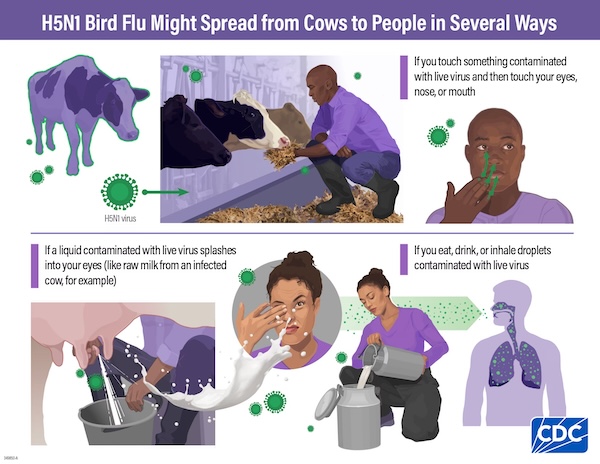The bird flu situation is starting to feel a little out of control with a new case seeming to appear everyday in poultry flocks, dairy herds, and/or humans. Just recently, a patient in Mexico tested positive for a bird flu strain that has never been found in humans before, H5N5. There are also reports indicating that bird flu (aka avian influenza) infections may be leading to more dairy cow losses than initially expected. Below are more details about the latest developments:
Humans: The World Health Organization (WHO) reported on June 5th, 2024, the first fatal victim of avian flu H5N2 virus in the world. The patient was a 59-year old man in Mexico with multiple underlying health conditions and who was not exposed to poultry or other farm animals. The sample was sequenced and indicated that it was positive for avian influenza strain H5N2, marking the first time this strain has been found in humans. However, health officials stress that the man had multiple health problems and it is not known how big a role the influenza infection played in his death. Additionally, the man may have been more susceptible to infection due to a compromised immune system. H5N2 is circulating in wild birds in Mexico. There have been no indications that any other people have contracted the virus or that human-to-human transmission is occurring.
In the US, three dairy workers have now been confirmed with H5N1 infections. The first two patients reported eye irritation and recovered within a few days. In the third case, the patient reported a cough and other minor respiratory symptoms in addition to eye symptoms. Experts said that the addition of respiratory symptoms doesn’t necessarily indicate that the virus has become more dangerous or that it may transmit more easily from person to person. Instead, they say, the person probably developed lung symptoms because of the route of infection, perhaps by breathing in infectious aerosols in the milking parlor instead of rubbing their eyes with contaminated hands. In the US, there have been no known cases of human-to-human transmission of the H5N1 virus.
Dairy Cows: Tests so far indicate that the virus detected in dairy cattle is H5N1. A Minnesota farm on June 6 became the 86th US dairy to test positive for avian influenza. Iowa the day before confirmed its first infection in a dairy herd. As of June 6, 2024, nine other states also have infected herds: 24 herds in Michigan, 18 in Idaho, 16 in Texas, 8 in New Mexico, 5 in South Dakota, 4 each in Kansas and Colorado, and 1 each in Ohio and North Carolina.
In its most recent update, the American Veterinary Medical Association says spread of the H5N1 virus within and among herds indicates that bovine-to-bovine spread occurs, likely through mechanical means. Evidence also indicates that the virus can spread from dairy cattle premises to nearby poultry facilities.
Reuters reported that dairy cattle in five states have died or been slaughtered by farmers because they did not recover. Many of the deaths appear to be related to secondary infections, according to people that Reuters spoke to. “You get sick cows from one disease, then that creates a domino effect for other things, like routine pneumonia and digestive issues,” explains Russ Daly, a professor with South Dakota State University and veterinarian for the state extension office.
Poultry: Avian Influenza has also unfortunately returned to US poultry farms this spring. Several large commercial flocks in Iowa have been hit including one layer operation that had to cull nearly 4.3 million birds and another with over 1 million birds. An outbreak at a commercial egg operation in Minnesota also led to the loss of more than 1 million birds. Outbreaks were confirmed in at least 10 commercial poultry operations in May. Overall, 92.34 million birds have been killed since the current H5N1 outbreak began in 2022, according to the U.S. Department of Agriculture.







